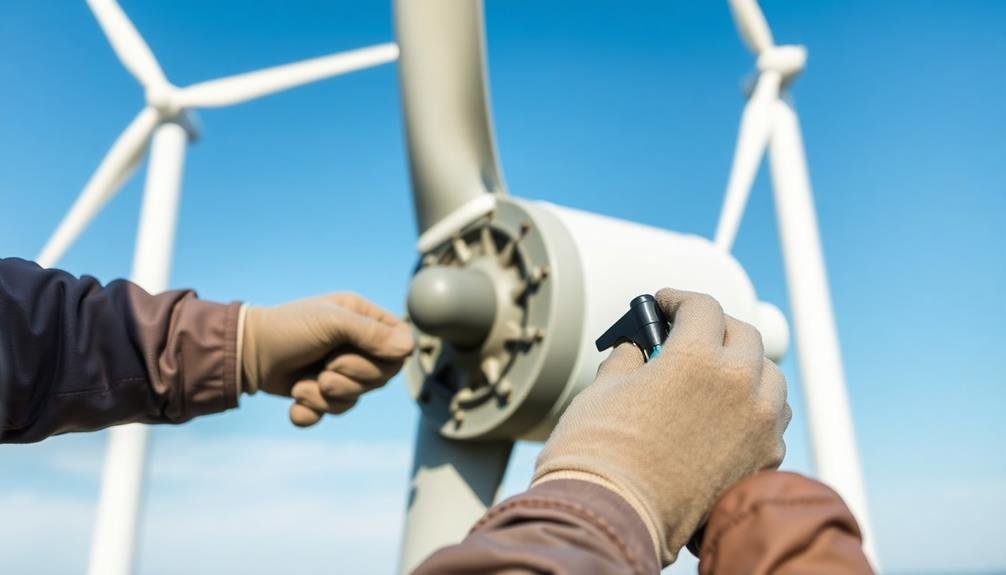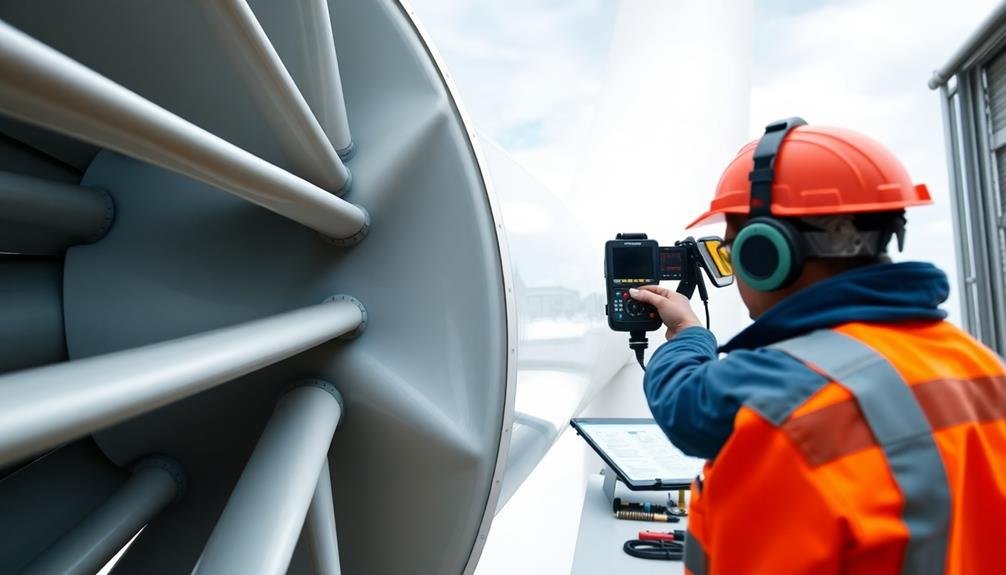To maximize your VAWT's lifespan, conduct monthly visual inspections, focusing on blades, rotor assembly, and electrical connections. Regularly lubricate bearings and replace them every 3-5 years. Clean and polish blades twice yearly, and tighten all connections. Maintain the generator by checking for unusual noises and corrosion. Assess structural integrity, including the tower and mounting system. Implement weather protection measures like coatings and lightning protection. Monitor performance with data logging systems and set up alerts for irregularities. Schedule annual professional servicing. By following these tips, you'll guarantee your VAWT operates efficiently for years to come. Discover more detailed maintenance strategies to keep your turbine spinning smoothly.
Regular Visual Inspections

For effective VAWT maintenance, regular visual inspections are essential. You should conduct these inspections at least once a month, focusing on key components of your vertical axis wind turbine.
Start by examining the blades for any signs of wear, cracks, or debris accumulation. Check the rotor assembly for proper alignment and verify all fasteners are secure. Inspect the generator and electrical connections for any loose wires or signs of corrosion.
Don't forget to assess the tower structure, looking for any rust, dents, or loose bolts. Pay attention to the foundation, checking for cracks or settling that could affect the turbine's stability.
Examine the brake system, confirming it's functioning correctly and not showing excessive wear. Look for any unusual noises or vibrations during operation, as these can indicate potential issues.
Keep a log of your inspections, noting any observations or concerns. This record will help you track the turbine's performance over time and identify recurring problems.
If you spot any issues during your visual inspection, address them promptly or consult a professional technician to prevent minor problems from escalating into major repairs.
Bearing Lubrication and Replacement
You'll need to master proper lubrication techniques to keep your VAWT's bearings in top condition.
Regular application of the correct lubricant, using the right amount and method, can greatly extend bearing life.
It's essential to follow a strict bearing replacement schedule, typically based on operating hours or annual inspections, to prevent unexpected failures and maintain ideal turbine performance.
Proper Lubrication Techniques
Proper bearing lubrication is essential for the smooth operation and longevity of your Vertical Axis Wind Turbine (VAWT). By following the right techniques, you'll guarantee peak performance and reduce wear on critical components. Start by selecting the appropriate lubricant for your VAWT's bearings, considering factors like temperature range, load, and speed.
To maintain your VAWT's bearings effectively:
- Clean the bearings thoroughly before applying new lubricant.
- Use the correct amount of grease – overgreasing can be as harmful as undergreasing.
- Apply lubricant at regular intervals, based on manufacturer recommendations.
- Monitor bearing temperature and noise levels to detect potential issues early.
When lubricating, use a grease gun to inject the lubricant slowly and evenly. This allows for proper distribution and prevents damage to seals.
Be sure to wipe away any excess grease to avoid attracting dirt and debris. If you're unsure about the lubrication process, consult your VAWT's manual or seek professional assistance.
Bearing Replacement Schedule
Regularly replacing bearings in your VAWT is vital for maintaining ideal performance and preventing catastrophic failures. The frequency of replacement depends on several factors, including turbine size, operating conditions, and bearing quality. As a general rule, you should replace bearings every 3-5 years or after 20,000-30,000 operating hours, whichever comes first.
Monitor your bearings closely for signs of wear, such as increased noise, vibration, or heat. If you notice any of these indicators, replace the bearings immediately, regardless of the scheduled timeframe. Keep detailed records of installation dates and operating hours to track each bearing's lifespan accurately.
When replacing bearings, always use high-quality components designed for wind turbine applications. Choose bearings with appropriate load ratings and seals to withstand environmental conditions.
It's important to follow proper installation procedures, including cleaning and lubricating the new bearings before installation. Consider using condition monitoring systems to track bearing health in real-time, allowing for predictive maintenance and optimized replacement schedules.
Blade Cleaning and Polishing

Over time, dirt, debris, and environmental contaminants can accumulate on the blades of your vertical axis wind turbine (VAWT), reducing its efficiency.
Regular cleaning and polishing are essential to maintain ideal performance and extend the lifespan of your turbine. You'll need to inspect your VAWT blades at least twice a year, or more frequently in dusty or polluted environments.
To clean and polish your VAWT blades effectively:
- Start by shutting down the turbine and securing it in a stationary position.
- Use a soft-bristled brush or sponge with mild, non-abrasive soap and water to gently remove dirt and grime.
- Rinse thoroughly with clean water to prevent soap residue from attracting more dirt.
- Apply a specialized wind turbine blade polish to protect the surface and improve aerodynamics.
Don't use harsh chemicals or abrasive materials, as they can damage the blade surface.
For hard-to-reach areas or stubborn stains, consider using a telescoping cleaning tool.
After cleaning, inspect the blades for any signs of wear, cracks, or damage. If you notice any issues, address them promptly to prevent further complications.
Regular blade maintenance will guarantee your VAWT operates at peak efficiency.
Tightening Loose Connections
Your VAWT's performance can suffer greatly from loose connections, leading to inefficiency and potential damage. Regular inspection and tightening of connections are essential for maintaining peak operation. Focus on key areas such as the rotor, generator, and support structure.
Start by examining the rotor assembly. Check and tighten bolts connecting blades to the central shaft. Verify the shaft bearings are secure and properly lubricated. Move on to the generator, tightening mounting bolts and inspecting electrical connections for corrosion or wear.
Don't overlook the support structure. Tighten foundation bolts and guy wire tensioners if applicable. Use a torque wrench to achieve proper tension without over-tightening, which can stress components.
| Component | Connection Points | Tightening Frequency |
|---|---|---|
| Rotor | Blade-shaft bolts | Monthly |
| Shaft bearings | Quarterly | |
| Hub connections | Bi-annually | |
| Generator | Mounting bolts | Quarterly |
| Electrical wires | Bi-annually |
Keep a maintenance log to track tightening schedules and any issues discovered. This practice helps identify recurring problems and guides future maintenance efforts. By consistently addressing loose connections, you'll extend your VAWT's lifespan and maintain its efficiency.
Generator Maintenance

Your VAWT's generator requires regular attention to guarantee peak performance.
You'll need to establish a consistent inspection schedule, replace brushes and bearings as they wear, and maintain the cooling system to prevent overheating.
Regular Inspection Schedule
Guaranteeing the longevity of your Vertical Axis Wind Turbine (VAWT) generator requires a consistent inspection routine. By implementing a regular schedule, you'll catch potential issues early and maintain peak performance. Aim to inspect your VAWT at least once every three months, with more frequent checks during extreme weather conditions or after storms.
During your inspections, focus on these key areas:
- Rotor blades: Check for cracks, chips, or deformities. Clean off any debris or buildup that could affect aerodynamics.
- Bearings and moving parts: Listen for unusual noises and look for signs of wear or inadequate lubrication.
- Electrical connections: Verify all wires are secure and free from corrosion. Tighten any loose connections.
- Structural integrity: Examine the tower and mounting system for stability and signs of stress.
Don't forget to keep detailed records of your inspections, noting any observations or maintenance performed. This documentation will help you track your VAWT's performance over time and identify recurring issues.
If you're unsure about any aspect of the inspection process, don't hesitate to consult a professional technician to guarantee your VAWT continues to operate safely and efficiently.
Brush and Bearing Replacement
A critical aspect of VAWT generator maintenance is the timely replacement of brushes and bearings. These components wear down over time, affecting your turbine's efficiency and power output. To guarantee peak performance, you'll need to inspect and replace them periodically.
For brushes, check their length every six months. When they've worn down to about half their original size, it's time for replacement. You'll typically need to replace brushes every 12-18 months, depending on usage. Always use manufacturer-recommended replacements to maintain proper contact and conductivity.
Bearings require attention to unusual noises, vibrations, or heat. Listen for grinding sounds and feel for excessive warmth around the generator housing. Replace bearings immediately if you notice these signs.
Even without obvious issues, plan to replace bearings every 3-5 years as preventive maintenance.
When replacing either component, clean the surrounding areas thoroughly. For bearings, apply fresh lubricant as specified by the manufacturer.
Keep detailed records of replacements to track wear patterns and enhance your maintenance schedule. By staying proactive with brush and bearing replacements, you'll extend your VAWT's lifespan and maintain peak performance.
Cooling System Maintenance
The cooling system is the unsung hero of your VAWT generator, keeping it from overheating during operation. Regular maintenance of this system is essential for your turbine's efficiency and longevity. To guarantee peak performance, you'll need to inspect and clean the cooling components periodically.
Start by checking the coolant levels and topping up if necessary. Use the manufacturer's recommended coolant to prevent corrosion and maintain proper heat transfer. Next, examine the cooling fins and heat sinks for any debris or dust buildup. Clean them gently with compressed air or a soft brush to improve heat dissipation.
Here's a quick checklist for cooling system maintenance:
- Inspect coolant hoses for leaks, cracks, or wear
- Clean or replace air filters to guarantee proper airflow
- Test the thermostat for proper functioning
- Lubricate cooling fans and check for smooth operation
Don't forget to consult your VAWT's manual for specific maintenance instructions and recommended intervals.
Brake System Check
Regularly inspecting your VAWT's brake system is essential for safe operation and longevity. Start by checking the brake pads for wear and tear. Replace them if they've worn down to less than 1/4 inch thick.
Examine the brake rotor for any signs of scoring, warping, or cracks. If you notice any of these issues, it's time for a replacement.
Next, inspect the brake cables for fraying, kinks, or corrosion. Lubricate them with a silicone-based lubricant to guarantee smooth operation.
Test the brake lever's responsiveness; it should engage smoothly without sticking. If you feel any resistance, investigate the cause immediately.
Don't forget to check the hydraulic brake system, if applicable. Look for leaks in the lines and guarantee the fluid level is adequate.
Bleed the system if you notice any sponginess in the brake lever.
Lastly, test the emergency brake system. Make sure it engages and disengages properly.
If you're unsure about any aspect of your VAWT's brake system, consult a professional technician. Regular maintenance will help prevent unexpected failures and keep your turbine running safely and efficiently.
Structural Integrity Assessment

To guarantee your VAWT's longevity, you'll need to assess its structural integrity regularly.
Start with visual inspection techniques to spot any obvious damage or wear, then analyze load-bearing components for signs of stress or fatigue.
You can also employ non-destructive testing methods to detect hidden flaws that might compromise the turbine's stability and performance.
Visual Inspection Techniques
While performing routine maintenance on your VAWT, it's crucial to conduct thorough visual inspections to assess structural integrity.
These inspections help identify potential issues before they become major problems, guaranteeing your turbine's longevity and peak performance.
Start by examining the turbine from ground level, using binoculars for a closer look at higher components. Pay attention to any visible damage, wear, or unusual discoloration on the blades, tower, and mounting structure.
Next, focus on these key areas during your visual inspection:
- Blade surfaces: Look for cracks, chips, or delamination. Check for any debris accumulation or changes in blade shape.
- Rotor hub and shaft: Inspect for signs of looseness, corrosion, or misalignment. Confirm all bolts and fasteners are secure.
- Tower and foundation: Examine for rust, cracks, or shifts in the foundation. Check guy wires (if applicable) for proper tension and condition.
- Electrical components: Verify that all cables, connections, and junction boxes are intact and free from damage or corrosion.
Document your findings and take photos for future reference.
If you notice any concerning issues, consult a professional technician for further assessment and repairs.
Load-Bearing Component Analysis
Beyond visual inspections, evaluating the structural integrity of your VAWT's load-bearing components is essential for maintaining its long-term reliability. Focus on critical areas such as the main shaft, bearings, and support structure. You'll need specialized tools like ultrasonic thickness gauges and vibration analyzers to assess these components accurately.
Start by measuring the thickness of key metal parts to detect any thinning due to corrosion or wear. Next, analyze vibration patterns to identify potential imbalances or bearing issues. Don't forget to check for fatigue cracks using non-destructive testing methods like dye penetrant or magnetic particle inspection.
Here's a quick reference guide for load-bearing component analysis:
| Component | Test Method | Frequency | Critical Value | Action |
|---|---|---|---|---|
| Main Shaft | Ultrasonic | Annually | <90% thickness | Replace |
| Bearings | Vibration | Quarterly | >5mm/s RMS | Lubricate |
| Support Structure | Visual | Monthly | Visible cracks | Repair |
| Blades | Tap test | Bi-annually | Hollow sound | Inspect |
| Bolts | Torque check | Quarterly | <90% spec | Tighten |
Non-Destructive Testing Methods
Non-destructive testing (NDT) techniques are essential for evaluating your VAWT's structural integrity without causing damage. These methods allow you to detect potential issues before they become critical, ensuring your turbine's longevity and performance.
By incorporating NDT into your maintenance routine, you'll minimize downtime and prevent costly repairs.
Here are four key NDT methods for your VAWT:
- Ultrasonic testing: Use sound waves to detect internal flaws in blades, shafts, and bearings.
- Thermography: Identify hot spots and potential failures with infrared imaging.
- Acoustic emission testing: Listen for stress-related sounds in materials under load.
- Eddy current testing: Detect surface and near-surface defects in conductive materials.
When performing NDT, focus on critical components like blade roots, hub connections, and main shaft bearings.
Regular inspections will help you spot early signs of fatigue, corrosion, or manufacturing defects. Remember to keep detailed records of your findings to track changes over time.
If you're unsure about interpreting results, consult with a certified NDT specialist.
Weather Protection Measures
Consistently protecting your Vertical Axis Wind Turbine (VAWT) from harsh weather conditions is essential for its longevity and performance. Start by applying a high-quality, weather-resistant coating to all exposed surfaces, including the blades, shaft, and support structures. This protective layer will shield against moisture, UV radiation, and corrosive elements.
Install lightning protection systems, including a grounding rod and surge protectors, to safeguard your VAWT from electrical damage during storms. Regularly inspect and maintain these systems to verify they're functioning correctly.
Implement a robust drainage system around the base of your VAWT to prevent water accumulation, which can lead to foundation issues and corrosion. Consider installing windbreaks or protective barriers if your turbine is in an area prone to extreme winds or flying debris.
During severe weather events, such as hurricanes or blizzards, you may need to temporarily shut down and secure your VAWT. Develop an emergency plan that includes procedures for safely stopping the turbine and securing loose components.
Lastly, monitor weather forecasts regularly and schedule maintenance checks after notable weather events to address any potential damage promptly. By taking these proactive measures, you'll considerably extend your VAWT's lifespan and maintain its efficiency.
Performance Monitoring

Regular performance monitoring is essential for maintaining your VAWT's efficiency and longevity. Keep a close eye on your turbine's output and compare it to expected performance levels. This will help you identify any issues early on, preventing costly repairs and maximizing energy production.
To effectively monitor your VAWT's performance, implement these key strategies:
- Install a data logging system to track power output, wind speed, and direction.
- Set up alerts for sudden drops in performance or unusual patterns.
- Conduct monthly visual inspections to check for visible damage or wear.
- Perform annual professional assessments to evaluate overall system health.
Don't forget to regularly calibrate your monitoring equipment to guarantee accurate readings. Keep detailed records of your VAWT's performance over time, including any maintenance or repairs performed. This data will be invaluable for spotting trends and predicting potential issues.
If you notice any significant deviations from expected performance, don't hesitate to consult with a professional. They can help diagnose problems and recommend appropriate solutions.
Professional Servicing Schedule
While monitoring your VAWT's performance is essential, professional servicing plays a key role in maintaining peak function. Establish a regular schedule for expert maintenance to guarantee your vertical axis wind turbine operates at its finest. Typically, you'll want to schedule professional inspections and servicing at least once a year, though this may vary based on your turbine's size, age, and local environmental conditions.
During these service appointments, specialists will conduct thorough checks of your VAWT's components. They'll inspect the blades for wear or damage, examine the bearings and shaft for proper alignment, and assess the generator's condition.
They'll also review your turbine's electrical systems, including wiring, inverters, and control mechanisms.
Professional technicians can perform more complex maintenance tasks, such as blade balancing, bearing replacements, and generator repairs. They'll also update software and firmware if necessary.
By adhering to a professional servicing schedule, you'll catch potential issues early, extend your VAWT's lifespan, and maintain peak energy production.
Don't forget to keep detailed records of these service visits, including any repairs or replacements made, to track your turbine's long-term performance and maintenance needs.
Frequently Asked Questions
How Does Temperature Affect VAWT Performance?
Temperature affects your VAWT's performance considerably. In cold weather, you'll see reduced efficiency due to increased air density. Hot temperatures can cause material expansion and reduced air density, impacting your turbine's output and overall effectiveness.
Can VAWTS Be Installed on Residential Rooftops?
Yes, you can install VAWTs on residential rooftops. They're often more compact and quieter than horizontal turbines, making them suitable for urban settings. However, you'll need to take into account structural support, local regulations, and potential vibrations before installation.
What's the Average Lifespan of a VAWT?
You can expect a VAWT to last 15-20 years on average. However, with proper maintenance and care, you'll find that some can operate efficiently for up to 25-30 years. Regular upkeep is key to maximizing its lifespan.
Are There Any Noise Concerns Associated With VAWTS?
Yes, VAWTs can produce noise. You'll hear a swishing sound as the blades rotate. It's typically less noticeable than horizontal turbines, but still consider placement carefully, especially in residential areas. Newer designs are working to reduce noise further.
How Do VAWTS Compare to Horizontal-Axis Wind Turbines in Efficiency?
You'll find that VAWTs generally have lower efficiency than horizontal-axis turbines. They typically convert less wind energy into electricity. However, VAWTs can work in more turbulent winds and don't need to face the wind direction.
In Summary
You've now got the essential tips for keeping your VAWT in top shape. Remember, consistent care is key to longevity. Don't skip regular inspections and maintenance tasks. Stay proactive with cleaning, lubricating, and tightening. Monitor performance and protect against weather damage. When in doubt, call in the professionals. By following these guidelines, you'll guarantee your VAWT operates efficiently for years to come, maximizing your investment in clean energy.





Leave a Reply